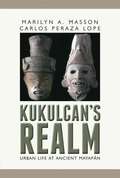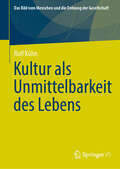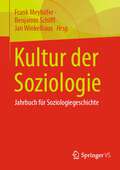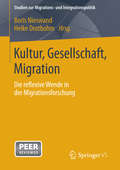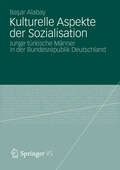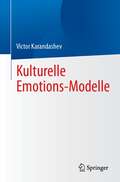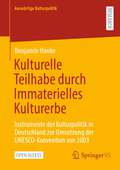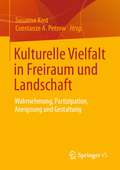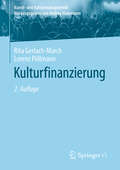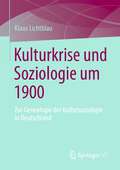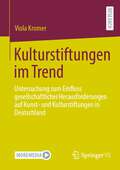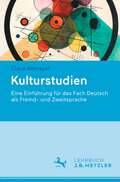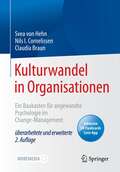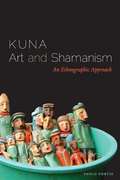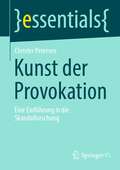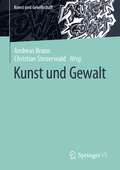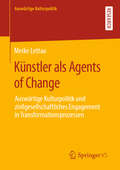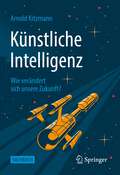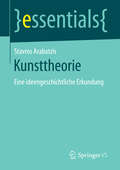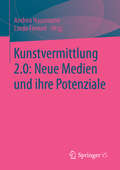- Table View
- List View
Kukulkan's Realm
by Marilyn Masson Carlos Peraza LopeKukulkan's Realm chronicles the fabric of socioeconomic relationships and religious practice that bound the Postclassic Maya city of Mayapán's urban residents together for nearly three centuries. Presenting results of ten years of household archaeology at the city, including field research and laboratory analysis, the book discusses the social, political, economic, and ideological makeup of this complex urban center.Masson and Peraza Lope's detailed overview provides evidence of a vibrant market economy that played a critical role in the city's political and economic success. They offer new perspectives from the homes of governing elites, secondary administrators, affluent artisans, and poorer members of the service industries. Household occupational specialists depended on regional trade for basic provisions that were essential to crafting industries, sustenance, and quality of life. Settlement patterns reveal intricate relationships of households with neighbors, garden plots, cultivable fields, thoroughfares, and resources. Urban planning endeavored to unite the cityscape and to integrate a pluralistic populace that derived from hometowns across the Yucatán peninsula.New data from Mayapán, the pinnacle of Postclassic Maya society, contribute to a paradigm change regarding the evolution and organization of Maya society in general and make Kukulkan's Realm a must-read for students and scholars of the ancient Maya and Mesoamerica.
Kultur als Unmittelbarkeit des Lebens (Das Bild vom Menschen und die Ordnung der Gesellschaft)
by Rolf KühnBestimmt man radikal phänomenologisch die Kultur als Subjekt wie Objekt ihrer selbst, dann beinhaltet dies eine jeweils gegebene Unmittelbarkeit des Lebens als Originarität aller subjektiv kulturellen Vollzüge. Dies wird methodisch in Auseinandersetzung mit empirischen wie transzendentalen Kulturanalysen wie bei Freud, Husserl, Henry und Derrida aufgegriffen, um sich danach inhaltlichen Manifestationen der Kultur wie Religion, Wissenschaft und Ästhetik zuzuwenden. Leitend bleibt dabei für die Zukunftsbestimmung unserer Kultur eine notwendige ko-pathische Aufmerksamkeit für das Leben, welche die Singularität aller kulturellen Vollzüge über die diskursive Begrenztheit eines rein objektivierenden Verständnisses hinaus am Werk sieht. Dabei wird auch dem Imaginären wie Fiktionalen ihr unumgehbares Recht eingeräumt, wie es besonders in der Kunst als Meta-Genealogie des Individuums und der Gemeinschaftlichkeit zum Ausdruck kommt.
Kultur der Soziologie: Jahrbuch für Soziologiegeschichte
by Frank Meyhöfer Benjamin Schiffl Jan WinkelhausDie mit diesem Sonderband versammelten Beiträge schlüsseln die Kultur der Soziologie soziologiegeschichtlich auf: Im Sinne der Kultivierungspraktiken der Soziologie nehmen sie in den Blick, in welchen institutionellen Arbeits- und Gesprächszusammenhängen sich soziologische Erkenntnisprozesse vollzogen haben. Sie geben damit Einblick in das historische Gewordensein der Kultur der Soziologie, so wie sie von Soziolog*innen je im Einzelfall verstanden und praktiziert wurde und – durch Anschlüsse wie Ausschlüsse gleichermaßen – wiederum als Nach- und Weitererzählungen in das disziplinäre Gedächtnis eingeht.
Kultur, Gesellschaft, Migration.
by Boris Nieswand Heike DrotbohmDer Sammelband arbeitet den Beitrag von Reflexivität für das Verständnis der Beziehung von Kultur, Gesellschaft und Migration anhand von drei Schwerpunkten heraus: 1. Politiken kultureller Differenz 2. Transnationale Perspektiven 3. Ethnizität und Diversität. Dafür werden Autorinnen und Autoren mit unterschiedlichen disziplinären Hintergründen aus Deutschland, Österreich, der Schweiz und den USA zusammengeführt. Im Zentrum steht die Beziehung zwischen der intellektuellen Krise, welche die bisherigen Grundbegriffe der Integrations- und Migrationsforschung erfasst hat, und der Entwicklung neuer thematischer Zuschnitte, theoretischer Konzepte und Forschungsansätze.
Kulturelle Aspekte der Sozialisation
by Başar AlabayBașar Alabay untersucht die Zusammenhänge zwischen türkischer geschlechtsspezifischer Erziehung junger Männer und deren Gewaltbereitschaft und Gewaltausübung. In der türkischen und kurdischen Gesellschaft in der Türkei und in den Zuwanderungsländern in Westeuropa haben Männer bestimmte Privilegien, die jedoch mit dem Zwang verbunden sind, nach außen stets eine bestimmte Form von Männlichkeit zu wahren. Bei Jungen erfolgt um die Zeit des Schuleintritts ein Wechsel aus der weiblichen in eine männliche Sphäre - durch die Beschneidung werden sie zu einem "Mann" gemacht. Der Autor analysiert, wie der dabei empfundene Schmerz, der abrupte Übergang aus einer weiblichen in eine männliche Welt Jungen zwingen kann, Gewalt anzuwenden, um die ihnen (vermeintlich) zustehende Achtung durch Jüngere und Frauen einzufordern. Für die aktuelle Diskussion über Gewalt von Jugendlichen und jungen Männern der zugewanderten Bevölkerung liefert er somit neue Perspektiven.
Kulturelle Emotions-Modelle
by Victor KarandashevDieses Buch bietet einen multidisziplinären Überblick über kulturelle Modelle von Emotionen, mit besonderem Augenmerk darauf, wie kulturelle Parameter von Gesellschaften das Gefühlsleben von Menschen in unterschiedlichen kulturellen Kontexten beeinflussen. Es geht über die traditionelle Dichotomie des West-Ost-Vergleichs und damit verbundene Kulturparameter wie Individualismus-Kollektivismus und Machtdistanz hinaus und untersucht auch viele andere kulturelle Dimensionen, die in der Mainstream-Forschung weniger Beachtung gefunden haben.Zu den behandelten Themen gehören:· Grundlegende emotionale Prozesse in kulturellen Kontexten· Kulturelle Komplexität von Emotionen· Kulturelle Werte des Überlebens und der Selbstdarstellung· Gesichtsausdruck von Emotionen in verschiedenen KulturenCultural Models of Emotion" ist ein umfassender Überblick über die internationalen Perspektiven der kulturübergreifenden Erforschung von Emotionen und eine nützliche Quelle für Forscher in den Bereichen Anthropologie, Soziologie, Psychologie und Kommunikationswissenschaften.
Kulturelle Teilhabe durch Immaterielles Kulturerbe: Instrumente der Kulturpolitik in Deutschland zur Umsetzung der UNESCO-Konvention von 2003 (Auswärtige Kulturpolitik)
by Benjamin HankeDieses Open-Access-Buch gibt einen umfassenden Überblick über die Verfahren und Abläufe der nationalen Umsetzung der UNESCO-Konvention zur Erhaltung des immateriellen Kulturerbes in Deutschland. Die Untersuchung konzentriert sich auf die Jahre unmittelbar vor und nach dem deutschen Beitritt zum Übereinkommen im Jahre 2013. Durch eine Politikfeldanalyse wird insbesondere der Frage nachgegangen, ob und wie die neue Aufgabe vom übergreifenden Ziel des Politikfelds, kulturelle Teilhabe zu steigern, beeinflusst wurde. Die Kombination aus einer Insiderperspektive des Autors mit einem analytischen Forschungsansatz dürfte für Vertreterinnen und Vertreter der Praxis des deutschen Mehrebenensystems der Kulturpolitik ebenso interessant sein wie für andere Forschende im Feld.
Kulturelle Vielfalt in Freiraum und Landschaft: Wahrnehmung, Partizipation, Aneignung und Gestaltung
by Susanne Kost Constanze A. PetrowKulturelle Vielfalt in Freiraum und Landschaft in ihrer Komplexität zu erfassen bedeutet, Räume von unterschiedlichen sozialen Gruppen und Milieus, von Werten, Praktiken und Lebensweisen her zu denken. Freiräume und Landschaften werden dabei ebenso als Schauplatz wie Produkt sozialen Handelns verstanden. Zugleich werden die kulturellen Ordnungen des Raumes und die damit verbundenen Machtverhältnisse hinterfragt.In Städten und Metropolregionen haben die Globalisierungsprozesse und Migrationsbewegungen der vergangenen Jahrzehnte zu einer neuen kulturellen Vielfalt geführt. Menschen unterschiedlicher Sozialisation nutzen öffentliche Freiräume gemeinsam, aber nicht immer auf die gleiche Weise. In Praktiken, Artefakten, Diskursen und Subjektivierungen werden Kultur und somit Raum- und Identitätskonstruktionen sichtbar.An der Schnittstelle zwischen Theorie und Praxis widmen sich die Autorinnen und Autoren dieses Bandes unterschiedlichen Dimensionen von Vielfalt in Stadt und Landschaft. Aus der Planung kommend fragen sie sowohl nach Aspekten der Wahrnehmung, Nutzung, Aneignung und Gestaltung von städtischen Freiräumen und Kulturlandschaften als auch nach den Chancen, Herausforderungen und Konflikten, die aus der kulturellen Vielfalt für die Freiraum- und Landschaftsplanung erwachsen.
Kulturfinanzierung (Kunst- und Kulturmanagement)
by Lorenz Pöllmann Rita Gerlach-MarchDieses Lehrbuch stellt Finanzierungsformen für Kulturbetriebe vor, ohne die Bereiche Staat, Markt und gemeinnütziger Sektor kategorisch zu trennen, da sie einander durchdringen und Kulturschaffende Grenzgänger zwischen diesen Welten sind. Nach einer theoretischen Einführung werden externe Finanzierungsquellen, öffentliche und private Mittel sowie neue Formen der „gemischten" Kulturfinanzierung beleuchtet, worauf von den Kulturinstitutionen selbst erwirtschaftete Einnahmen folgen. Sie werden jeweils kurz eingeführt und aktuell praxisorientiert illustriert. Dabei liegt das Augenmerk auf besonders innovativen Finanzierungsmodellen, und erfolgreiche Beispiele werden als „best practice" detailliert beschrieben.
Kulturkrise und Soziologie um 1900: Zur Genealogie der Kultursoziologie in Deutschland
by Klaus LichtblauDieses Buch hat die Entstehung der Kultursoziologie in Deutschland im Zeitraum von 1887 bis 1933 zum Gegenstand. Ausgehend von der um 1900 weit verbreiteten Kulturkritik im deutschen Sprachraum wird zum einen die Bedeutung der Nietzsche-Rezeption und der Auseinandersetzung mit der ästhetisch-literarischen Moderne für die frühe deutsche Soziologie aufgezeigt. Die Konfrontation mit der modernen Geschlechterfrage und der Krise der Wissenschaft sind weitere Schwerpunkte der vorliegenden Abhandlung. Ausführlich behandelt werden dabei die entsprechenden Arbeiten von Ferdinand Tönnies, Georg Simmel, Max Weber, Werner Sombart, Max Scheler und Karl Mannheim.
Kulturstiftungen im Trend: Untersuchung zum Einfluss gesellschaftlicher Herausforderungen auf Kunst- und Kulturstiftungen in Deutschland
by Viola KromerIn diesem Buch werden die Strukturen der Kunst- und Kulturförderung in Deutschland untersucht. Die Autorin konzentriert sich dabei auf das Phänomen des Kulturstaats, der öffentlichen Kulturförderung, der stifterischen Kulturförderung sowie der Rolle des Staats als Stifter. Mit einem Basisdatensatz von über 7.000 Kulturstiftungen wird die Grundlage für die empirische Forschung geschaffen. In der Studie wird das Verhältnis von Kunst- und Kulturstiftungen zu zukunftsrelevanten gesellschaftlichen Entwicklungen analysiert und das Potenzial, das in der Verknüpfung von Kunst und Kultur mit diesen Entwicklungen liegt, untersucht. Anhand einer Befragung unter Stiftungen und einer Auswertung von Stiftungsprojekten werden die Fragen beantwortet, ob sich Kunst- und Kulturstiftungen zukunftsrelevanten gesellschaftlichen Entwicklungen widmen möchten und ob sie dies in ihrer Praxis tatsächlich tun. Im abschließenden Kapitel werden die Ergebnisse der Arbeit zusammengefasst, Thesen formuliert und ein Ausblick auf weitere, thematisch einschlägige Forschung gegeben. Die Studie bietet somit einen umfassenden Einblick in die Rolle von Kunst- und Kulturstiftungen im Kontext gesellschaftlicher Entwicklungen und deren Potenzial für die Zukunft.
Kulturstudien: Eine Einführung für das Fach Deutsch als Fremd- und Zweitsprache
by Claus AltmayerDiese Einführung macht mit den wichtigsten Problemstellungen, Konzepten und Lösungsansätzen des Wissenschaftsbereichs Kulturstudien im Fach Deutsch als Fremd- und Zweitsprache vertraut. Wozu ist die Beschäftigung mit Kultur beim Lernen von Deutsch nötig? Was genau ist mit ‚Kultur‘ gemeint? Und wie kann man sie beschreiben? Daneben kommen aktuelle Ansätze des ‚kulturbezogenen Lernens‘ sowie Forschungsperspektiven zur Sprache. Das Buch richtet sich an Studierende, Lehrende und Forschende des Fachs DaF/DaZ sowie an alle, die an Fragen von Kultur und Kulturvermittlung interessiert sind.
Kulturwandel in Organisationen: Ein Baukasten für angewandte Psychologie im Change-Management
by Nils I. Cornelissen Claudia Braun Svea von HehnKulturveränderung in vier Schritten! Dieses Fachbuch bietet Ihnen konkrete Werkzeuge für die vier iterativen Phasen eines Kulturwandels, u.a. wie durch viralen Change großflächige Veränderung in kurzer Zeit passiert und veranschaulicht die Techniken mit praxisnahen Fallbeispielen aus der Unternehmenswelt. Es bringt die hierfür wichtigsten Erkenntnisse aus der angewandten Psychologie auf den Punkt. Die Autoren verknüpfen auf verständliche Weise praktische Handlungsanleitungen aus ihrer jahrzehntelangen Beratungserfahrung mit den Erkenntnissen der Verhaltensökonomie und der Neurowissenschaften. Dazu sind Fragen und Antworten zum Selbsttest über die Flashcard App inkludiert. Der Inhalt • Konkrete Werkzeuge für die vier iterativen Phasen eines Kulturwandels, u.a. wie Vorbilder geschaffen werden und Change Stories überzeugender sein können• Praxisnahe Fallbeispiele aus der Unternehmenswelt, u.a. zu Wandel durch Digitalisierung • Fundiertes Hintergrundwissen zu Verhaltens- und Einstellungsänderung, u.a. zu Willenskraft (Willpower) und Gewohnheitsänderungen, Mindsets und Sinnhaftigkeit (Purpose) als Veränderungstreiber• Fünf grundlegende Designprinzipien, u.a. was IKEA-Regalaufbauen mit Wandel zu tun hat• Tipps für Akteure des Kulturwandels, wie sie mittels emotionaler Intelligenz und Achtsamkeit Resilienz stärken und Veränderung auch gegen Widerstände meistern• Hilfreiche Didaktik durch Zusammenfassungen, Checklisten der Erfolgsfaktoren, Hintergrund-, Reflexions- und Übungsboxen Die Zielgruppen Führungskräfte, Organisationsentwickler, Personaler und Berater in Startups, im Mittelstand und in größeren Unternehmen sowie öffentlichen Organisationen Die Autoren Dr. Svea von Hehn arbeitet seit 1999 international als Managementberaterin (u.a. für McKinsey). Sie ist diplomierte, promovierte Psychologin, mehrfach zertifizierter systemischer Coach (u.a. für Search Inside Yourself, Google’s Achtsamkeitsprogramm) und Partnerin bei RETURN ON MEANING. Nils I. Cornelissen arbeitet seit 2003 international als Managementberater (u.a. für McKinsey). Er ist Diplom-Kommunikationswirt und hat einen Master in Psychologie und Soziologie. Er ist zertifizierter Coach sowie Facilitator und Partner bei RETURN ON MEANING. Claudia Braun arbeitet seit 2007 international als Managementberaterin (u.a. für McKinsey). Sie ist Diplom-Betriebswirtin in internationaler BWL, hat einen Master of Public Administration, einen Master of Public Policy sowie diverse Zertifizierungen z.B. als systemischer Coach und MBSR-Trainerin. Sie ist Partnerin bei RETURN ON MEANING.
Kuna Art and Shamanism: An Ethnographic Approach
by Paolo FortisKnown for their beautiful textile art, the Kuna of Panama have been scrutinized by anthropologists for decades. Perhaps surprisingly, this scrutiny has overlooked the magnificent Kuna craft of nuchukana-wooden anthropomorphic carvings-which play vital roles in curing and other Kuna rituals. Drawing on long-term fieldwork, Paolo Fortis at last brings to light this crucial cultural facet, illuminating not only Kuna aesthetics and art production but also their relation to wider social and cosmological concerns. Exploring an art form that informs birth and death, personhood, the dream world, the natural world, religion, gender roles, and ecology, Kuna Art and Shamanism provides a rich understanding of this society's visual system, and the ways in which these groundbreaking ethnographic findings can enhance Amerindian scholarship overall. Fortis also explores the fact that to ask what it means for the Kuna people to carve the figure of a person is to pose a riddle about the culture's complete concept of knowing. Also incorporating notions of landscape (islands, gardens, and ancient trees) as well as cycles of life, including the influence of illness, Fortis places the statues at the center of a network of social relationships that entangle people with nonhuman entities. As an activity carried out by skilled elderly men, who possess embodied knowledge of lifelong transformations, the carving process is one that mediates mortal worlds with those of immortal primordial spirits. Kuna Art and Shamanism immerses readers in this sense of unity and opposition between soul and body, internal forms and external appearances, and image and design.
Kunst der Provokation: Eine Einführung in die Skandalforschung (essentials)
by Christer PetersenWie können die Charakteristika, die Themen, Inhalte und Verläufe von modernen Skandalen in den Massenmedien beschrieben werden, wie die kommunikativen Verfahren und Ökonomien der Generierung öffentlicher Empörung, denen Skandale der Politik, der Kunst und Kultur heute folgen? Dieses Essential bietet eine prägnante Einführung in den Status quo der Skandaltheorie und zeichnet am Fallbeispiel Skandalisierungsverfahren als eine Kunst der Provokation öffentlicher Aufmerksamkeit nach.
Kunst und Gewalt (Kunst und Gesellschaft)
by Andreas Braun Christian SteuerwaldDas Buch untersucht den bisher nur unzureichend untersuchten Zusammenhang von Kunst und Gewalt. Mit theoretischen, empirischen und methodischen Beiträgen von Gewalt- und Kunstsoziolog:Innen richtet sich das Buch nicht nur an ein soziologisches Fachpublikum, sondern zugleich auch an eine breite sowohl an Kunst als auch Gewalt interessierte Öffentlichkeit.
Künstler als Agents of Change: Auswärtige Kulturpolitik und zivilgesellschaftliches Engagement in Transformationsprozessen (Auswärtige Kulturpolitik)
by Meike LettauKünstler und Kulturaktivisten nehmen als Agents of Change eine zentrale Rolle in gesellschaftspolitischen Transformationsprozessen ein. Die Studie untersucht die Rolle zivilgesellschaftlicher Akteure am Beispiel von Kunstfestivals im öffentlichen Raum im Kontext der Umbrüche in Tunesien in den Jahren 2010/11 und der politischen Transformation von einem diktatorischen zu einem demokratischen System. Darüber hinaus werden neue Aufgaben, Herausforderungen und Chancen auf dem Gebiet deutscher auswärtiger Kulturpolitik am Beispiel der kulturellen Programmarbeit und Kooperationsansätze des Goethe-Instituts betrachtet sowie ein Paradigmenwechsel für das Politikfeld entwickelt.
Künstliche Intelligenz: Wie verändert sich unsere Zukunft?
by Arnold KitzmannKünstliche Intelligenz (KI) durchdringt zunehmend unser gesamtes Leben, angefangen bei den hochwillkommenen kleinen Erleichterungen des Alltags bis hin zu gravierenden gesellschaftlichen Veränderungen in Arbeitswelt, Forschung und Entwicklung sowie der Privatsphäre jedes Einzelnen. Wir können uns dieser Entwicklung nicht (mehr) entziehen oder gar verweigern, sondern sind gefordert, uns mit ihr auseinanderzusetzen. Dieses Buch erörtert philosophische, ethische, politische, ökonomische Aspekte ebenso wie die Problematik der Selbstbestimmtheit, Freiheit und Manipulierbarkeit des Einzelnen. So entsteht ein kleiner Leitfaden für den Leser, um sich selbst in dieser Phase großer gesellschaftlicher Umwälzungen zu positionieren. Last not least spannend: In der Auseinandersetzung mit Künstlicher Intelligenz wird klar, dass sie uns Heutigen mit Fragen konfrontiert, die bereits die Philosophie vor über zweieinhalb Jahrtausenden umtrieb.
Kunsttheorie: Eine ideengeschichtliche Erkundung (essentials)
by Stavros ArabatzisDieses essential bietet eine ideengeschichtliche Erkundung des modernen Begriffs von Kunst. Es leistet eine theoretische Unterscheidung zwischen dem alten und neuen Kunstbegriff (,,Kultwert" und ,,Ausstellungswert") und zeigt zugleich ihre beider Ununterscheidbarkeit im neuen Kultgegenstand der interaktiv-vernetzten Kultur. Es schl#65533;gt Positions- und Kursbestimmungen f#65533;r eine zuk#65533;nftige Kunst vor, die den imperativen M#65533;chten nicht mehr gehorcht.
Kunstvermittlung 2.0: Neue Medien und ihre Potenziale
by Andrea Hausmann Linda FrenzelDie Neuen Medien eröffnen vielfältige Chancen für die Vermittlungsarbeit in Museen, Ausstellungshäusern und anderen Kultureinrichtungen. Vor allem ermöglichen sie eine verbesserte, direkte Einbeziehung der Besucher in die Inhalte. Die Auseinandersetzung mit Kunst wird so zu einem spannenden, partizipativen und interaktiven Erlebnis. Es ist Ziel dieses Buchs, die Potenziale der Neuen Medien für die Vermittlungsarbeit in Kunst und Kultur fundiert zu untersuchen und im Hinblick auf die Gewinnung, Entwicklung und Bindung von Besuchern praxisnah zu beleuchten.
Kunstvermittlung 2.0: Neue Medien und ihre Potenziale
by Andrea Hausmann and Linda FrenzelDie Neuen Medien eröffnen vielfältige Chancen für die Vermittlungsarbeit in Museen, Ausstellungshäusern und anderen Kultureinrichtungen. Vor allem ermöglichen sie eine verbesserte, direkte Einbeziehung der Besucher in die Inhalte. Die Auseinandersetzung mit Kunst wird so zu einem spannenden, partizipativen und interaktiven Erlebnis. Es ist Ziel dieses Buchs, die Potenziale der Neuen Medien für die Vermittlungsarbeit in Kunst und Kultur fundiert zu untersuchen und im Hinblick auf die Gewinnung, Entwicklung und Bindung von Besuchern praxisnah zu beleuchten.
